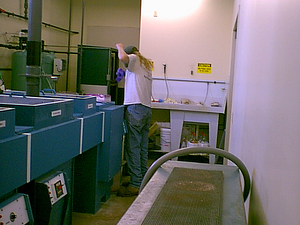Benefits of Working with an Outside Photo Etching Supplier
 Twenty-five or so years ago, the photo etching process was a lot more common in manufacturing, particularly for printed circuit boards. Back then, there were at least 100 companies, just in Connecticut, that etched circuit boards. Today, there are barely a handful and only a few hundred in the country. As pcb manufacturing migrated overseas, the knowledge base for photo etching declined.
Twenty-five or so years ago, the photo etching process was a lot more common in manufacturing, particularly for printed circuit boards. Back then, there were at least 100 companies, just in Connecticut, that etched circuit boards. Today, there are barely a handful and only a few hundred in the country. As pcb manufacturing migrated overseas, the knowledge base for photo etching declined.
When there was a population of people who had etching experience, there were companies that decided to do their own etching. In those days, environmental requirements were less rigorous and the costs of waste management were much lower. Over the intervening years, things have changed quite significantly with regard to photo chemical etching.
Today, environmental compliance costs, safety, and waste treatment and disposal are significant cost factors for etching. Interestingly, there are about the same number of commercial photo etching companies today as there were 25 plus years ago.
In addition to shouldering the costs of the regulatory and environmental burdens, photo etching equipment is not a long-lived asset. Exposure to the etching solution, which is both heated and pressurized, takes its toll on the conveyors, bearings, and pumps. We routinely replace equipment every four years. If you are etching only part time, or intermittently, your etching equipment is degrading in place.
There are eight reasons why you should be working with a commercial photo etching supplier rather than doing your chemical etching in house:
1. Utility Costs: chemical etching equipment uses a ton of power to run compressors, pumps, conveyors and sprayers. The etching process also uses a lot of water for regeneration, rinsing, developing and stripping.
2. Chemistry and supply costs: Etchant, developer, stripper and photoresist are significant elements in the cost of goods. And, if you are not etching on a continuous basis, those costs are not amortized efficiently.
3. Waste treatment and disposal: Even with on-site waste treatment, what and how much can be put down the drain is tightly regulated. Other wastes must be processed by regulated facilities and everything has to be accounted for and documented in perpetuity.
4. Regulatory and compliance costs: It's not enough to follow the rules. You have to pay permit fees, audit fees, consulting fees, disposal fees and more, just for the fact of using photo etching as a manufacturing process. And, don't forget the potential for fines if you have a problem.
5. Maintenance and repair costs: Photo etching equipment requires regularly scheduled M&R, just like an airplane. After every so many hours of operation, there are parts that need to inspected, serviced or replaced. Keeping an etching line running for 4 years isn't like keeping a refrigerator plugged in.
6. Capital Expenses: After keeping an etching line running for four years, you still have to replace it. Just write a check in the six-figure range.
7. Training and Safety: There are state- and federally-mandated safety training requirements for which a certified instructor is required. Every new employee must be trained to the requirements and every employee must complete retraining annually.
8. Determining your true cost of goods: Do you really know what your etching costs are? It's not just the cost of the metal. What about the defective parts you make? What about unabsorbed overhead related to start up and shut down? What about production efficiency? Can you run that equipment as productively as a full time facility?
When you work with a commercial etching facility, all of these issues evapor


